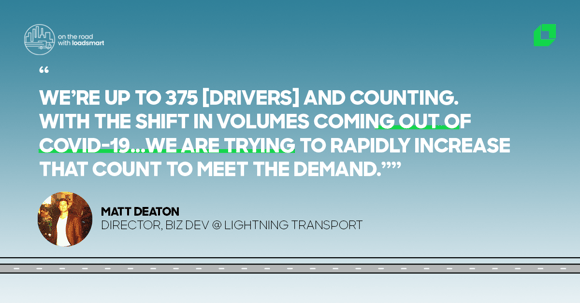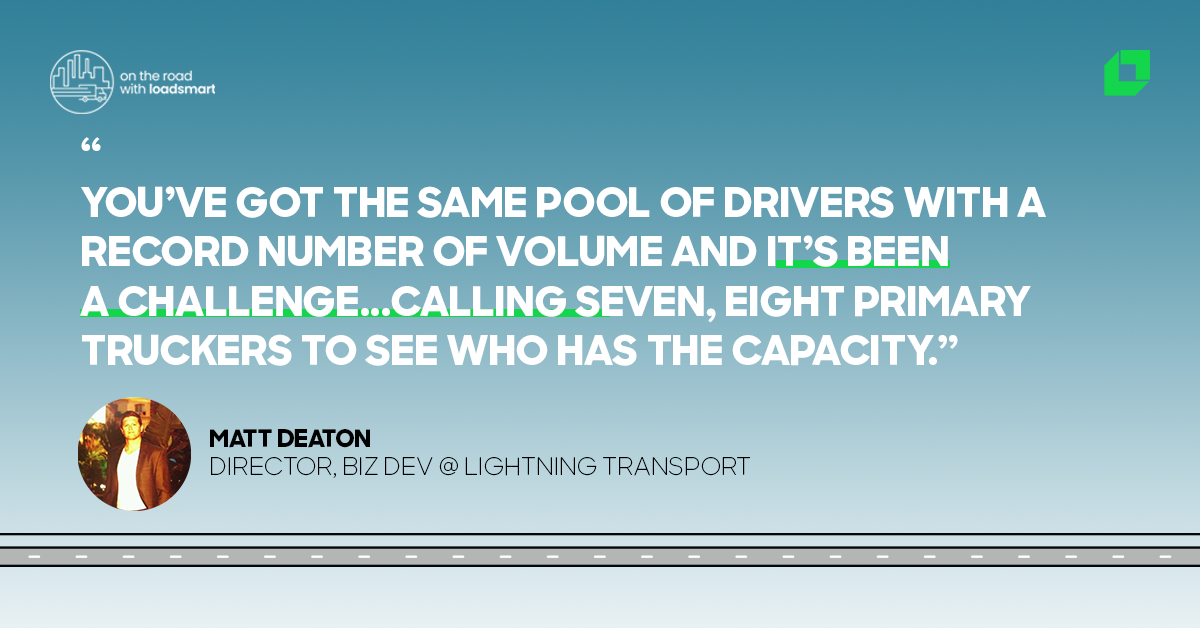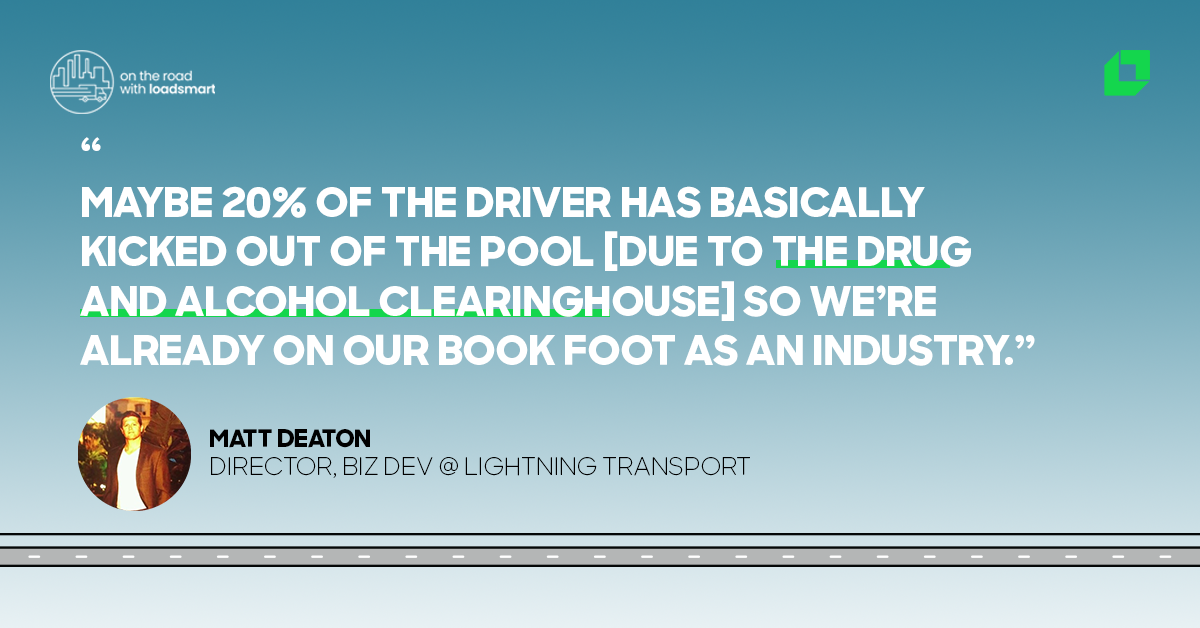Share this
On the Road with Loadsmart Ep 5: Lightning Transport
by aaronroseman
We’re in the business of connecting the logistics industry, but that doesn’t stop at connecting shipments with carriers. This is our second episode of On the Road with Loadsmart, a platform to connect the industry to the stories that matter, inspire, and are essential for giving credit to the unsung heroes of the road we have the privilege to work with every day.
In this episode Aaron from Loadsmart sits down with Matt Deaton from Lightning Transportation to discuss how they’re dealing with growing a driver pool of 375+ drivers to keep up with the recent shifts in demand and volume.
Aaron: To dive right in, do you want to tell us a little bit about Lightning Trans?
Matt: We are a drayage service provider all over the East Coast. I work with our operations teams, sales, business development, working directly with our customers. We’ve been in business since about 1987. We started with one terminal in Baltimore and we’re up to about eight terminals now.
All the major ports and rails and actually we were looking to expand this year.

Right now we’re up to about 375 and counting with the shift in volumes recently coming out of COVID-19 we’ve got a nice, strong pipeline of drivers that we’re trying to rapidly increase that count as we speak to meet the demand and the recent shifts in volumes.
Aaron: Do you want to tell us a little bit about what your main challenges were at the beginning of the year and when the East Coast shut down and a lot of the ports did what those goals and challenges transitioned to?
Matt: Coming out of Chinese New Years right at the end of February start of March California went into shutdown mode New York followed and then state by state just started dropping. Usually it’s a slowdown during that Chinese New Year and then it progresses to start picking back up. Volumes start really shifting and increasing rapidly, but this year we didn’t have that. When things started opening back up it was a slow progression – things started increasing a little bit and now as far as the East Coast markets that we are involved with and just talking to my colleagues in the industry pretty much all the major port and rail markets, East Coast West Coast are seeing record levels of freight volumes that’s surpassed anything they’ve experienced or had in the past.

You’ve got the same pool of drivers with a record number of volume and it’s really been a challenge not just for us as a company or the trucking industry, but I’m sure on the forwarder side as well where you have two or three primary truckers with competitive rates that you would immediately go to to where probably you’re looking at calling 7 or 8 down the line to see who has the capacity just to move the containers that you’re needing to be moved.
Aaron: Can this persist?
Matt: We hope that the volumes will sort of level off and some of it is actually is just trying to reestablish their inventories from being depleted. But at the same time as far as the driver capacity and the driver pool?

People getting into trucking is not what it used to be where your son, father or brother, sister what have you family lineage and background in the trucking industry that’s not to say it’s not going to be OK, but the rules and regulations I think getting into trucking – I had a conversation today with one of my colleagues – there’s a drug and alcohol clearinghouse that’s been established this year and they said that maybe 20% of the drivers that were available have been basically kicked out of the pool of what was the driver pool last year so we’re already on our back foot as an industry to be able to meet the service demand right now.
Aaron: Do you see there being some sort of shift in the industry whether it’s embracing new technologies or reanalyzing the way the supply chain has operated in order for capacity to keep up with volume?
Matt: You probably know this and Loadsmart being heavily invested in technology investing in the efficiencies of using technology that I do believe technology is changing obviously as you know every year and with that comes transparency and visibility and I think the entire industry is moving more toward that and customers are trying to demand that expectation more we worked with your team. Project 44 we’ve been working on implimenting that’s going to be a huge resource for Loadsmart and for Lightning as far as transparency. And I do think the technology will hopefully help not have these surges in volumes and being able to have more of a balance than imbalance.
Aaron: Twenty years ago when you were a dispatcher how would you compare the level of transparency you had then with where it is today and where you think it’s gonna go?

Matt: The game has been completely changed. Like I was telling you, I started out as a third shift dispatcher and it was pretty much phone calls – which we still do a lot of personal communication now – phone calls and emails, but still the lag time between having to actually get in contact with someone to make sure you got that final confirmation. The change in real-time transparency and visibility in terms of the entire supply chain from origin to destination whether it be foreign or domestic has completely changed.
More stories, more episodes
Stay up to date with everything we find in our On the Road Episodes as we criss cross the country talking to our network of carriers on our YouTube channel.
Are you a carrier? Join Matt and thousands of other carriers who are benefiting from the efficiencies of technology.
Share this
- Market Trends (76)
- Carrier (64)
- Enterprise Shipper (62)
- Data Insights (49)
- Shipper (49)
- News (44)
- Blog (43)
- SMB Shipper (37)
- Thought Leadership (35)
- Our Partners (29)
- Product Updates (23)
- Mode Optimization (21)
- Warehouse (19)
- Mid-Market Shipper (14)
- Instant Execution (4)
- Asset (3)
- Video (3)
- eBook (3)
- Case Study (2)
- Freight Management (1)
- April 2024 (3)
- March 2024 (2)
- February 2024 (2)
- January 2024 (5)
- December 2023 (6)
- November 2023 (2)
- October 2023 (12)
- September 2023 (5)
- August 2023 (3)
- July 2023 (4)
- June 2023 (10)
- May 2023 (6)
- April 2023 (5)
- March 2023 (7)
- February 2023 (5)
- January 2023 (7)
- December 2022 (4)
- November 2022 (13)
- October 2022 (4)
- September 2022 (7)
- August 2022 (11)
- July 2022 (6)
- June 2022 (5)
- May 2022 (2)
- April 2022 (4)
- March 2022 (6)
- February 2022 (7)
- January 2022 (9)
- December 2021 (3)
- November 2021 (5)
- October 2021 (7)
- September 2021 (2)
- August 2021 (2)
- July 2021 (4)
- June 2021 (6)
- May 2021 (6)
- April 2021 (5)
- March 2021 (8)
- February 2021 (3)
- January 2021 (3)
- December 2020 (7)
- November 2020 (9)
- October 2020 (7)
- September 2020 (6)
- August 2020 (10)
- July 2020 (8)
- June 2020 (3)
- May 2020 (1)
- April 2020 (2)
- March 2020 (2)
- February 2020 (1)
- January 2020 (1)
- November 2019 (2)
- October 2019 (1)
- September 2019 (2)
- August 2019 (3)
- July 2019 (2)
- June 2019 (2)
- May 2019 (3)
- March 2019 (1)
- February 2019 (3)
- December 2018 (1)
- November 2018 (2)
- October 2018 (1)
- September 2018 (2)
- August 2018 (1)
- July 2018 (1)
- June 2018 (3)
- May 2018 (4)
- April 2018 (1)
- February 2018 (1)
- January 2018 (4)
- November 2017 (1)
- October 2017 (2)
- June 2017 (1)
- May 2017 (2)
- April 2017 (1)
- February 2017 (1)
- January 2017 (2)
- October 2016 (1)
- August 2016 (1)
- July 2016 (2)
- June 2016 (1)
- March 2016 (1)
- January 2016 (1)
- December 2015 (3)
- November 2015 (2)
- October 2015 (6)
- July 2015 (1)
- June 2015 (1)
- April 2015 (2)
- March 2015 (13)
- February 2015 (17)
- January 2015 (15)
- December 2014 (35)
- November 2014 (26)
- October 2014 (60)
- September 2014 (2)